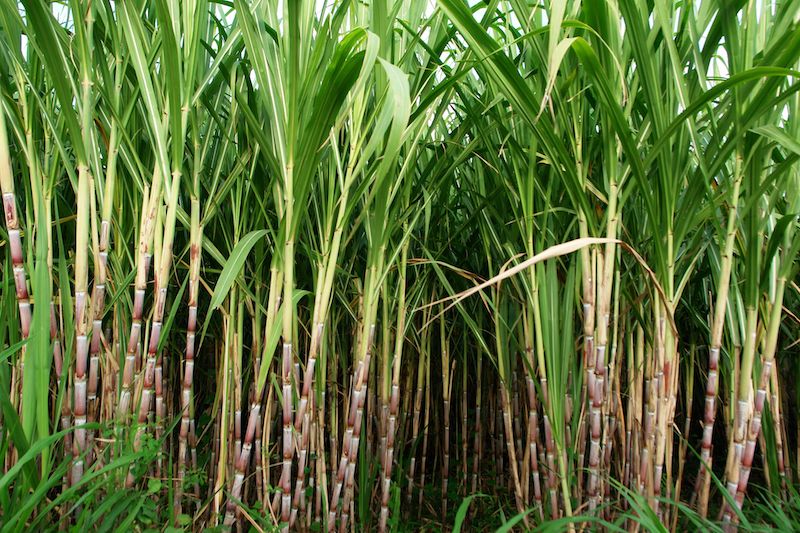Sugarcane is a unique crop in many ways. While it is popularly associated with the crop that gives us that white gem that is sugar, most don’t know that sugarcane gives us much more than just the ‘sweet’ part to so many of our foods. This article provides an introduction to the versatility and upcyclability of sugarcane as a crop, and how sugarcane is becoming all the more important to nurture and further learn more about for the future.
Sugarcane: a fruitful grass
Sugarcane is a type of grass, with stout and fibrous stalks, and, as the name indicates, is responsible for almost 85% of total global sugar production. Sugarcane is grown virtually anywhere in the tropics and subtropical regions of the world, with Brazil (ca. 45% of global production) and India (ca. 20% of global production) being the first and second largest producers respectively. Sugarcane is also the world’s largest crop by production quantity, with 1.9 billion tonnes produced in 2018.
Describing the sugarcane industry as ‘key’ for Brazil may be an understatement. In Brazil alone, the world’s largest sugarcane producer, it brings almost 50 billion dollars every year, and gives more than 1.1 million Brazillian people jobs in the sector. Whilst refined and natural sugar, produced primarily through the crushing and juicing of sugarcane stalks, is definitely the largest market and produce from these huge production chains, it is only one part of sugarcane’s produce and merits as a crop.

Ethanol as a more sustainable fuel alternative
Ethanol production is the second largest product of sugarcane farming and, similarly to sugar, is produced through the crushing and juicing of the sugarcane stalks. The Brazilian ethanol market is also the world’s biggest- with around 50% of sugarcane produced in Brazil destined for domestic ethanol production. In 2019, there were almost 17x more ‘flex fuel’ (i.e. primarily ethanol-powered) cars than diesel and gasoline cars combined on the Brazilian roads- this is a fascinating statistic, particularly as flex fuel-powered cars didn’t exist more than around 10 years ago.
.jpg)
Furthermore, recent legislative changes in other large countries such as the USA and India have recently passed making it law that many gasoline and fossil fuel solutions need to be composed of up to 25% of ethanol. With such laws, ethanol can also be seen as reducing fossil fuel emissions which in turn inflicts less environmental damage.
A recent finding by an international team of scientists and academics went as far as seeing a vast expansion of Brazilian sugarcane production to help satisfy massively increasing demand for ethanol as having the ability to reduce global CO2 emissions by 5.6% before the end of this decade. That being said, expanding sugarcane production at such a scale would require large production fields eventually leading to deforestation- a topic and phenomenon that is already highly controversial.
Improving yields on existing fields is a way to deal with the expansion demand. Gamaya’s CaneFit solution allows for a smarter agronomic management with intelligence from remote sensing throughout the crop cycle, aiming at producing more with less.
Nothing is lost, everything is transformed
But sugarcane doesn’t supply only the sugar market and the booming and rapidly growing ethanol market. In normal plants the remainder would go to waste- but with sugarcane this is not the case. One is able to extract and upcycle product from all the remaining elements of the crop. Bagasse, the left-over material from the stalk crushing and juicing process, is a great example of this.
Bagasse is the dry, pulpy material that remains after crushing sugarcane stalks for juice used in ethanol and sugar production. For every 10 tonnes of sugarcane crushed, a sugar factory produces around three tonnes of bagasse.
Paper is one example of a product that benefits from the high moisture content- many Latin American countries have this as one solution to use up their large bagasse reserves. Some also go on to use it for manufacturing animal feeds- with bagasse’s high cellulose content making it very nutritious for livestock.

Yet the most interesting application of bagasse is its ability to be converted into bioenergy, primarily used in the form of bioelectricity. In 2016, bioenergy was accountable for more than 20% of the total national Brazilian power energy supply– the majority of this was used in the form of bioelectricity. It has even been predicted that with the complete use of all bagasses produced in Brazil every year, enough bioelectricity could be produced to fully power a country the size of Argentina for a year. Some Indian districts have even targeted to derive all 100% of their electricity from bagasse by 2025, and similar schemes are being devised in Southern Africa by using excess pastureland to grow sugarcane.
Statistics from Brazil in 2020 have shown that their generation of bioelectricity from bagasse led to an avoidance of 6.3 million tonnes of CO2 emissions- a number equivalent to the cultivation of 44 million trees over a period of 20 years. Ultimately then, reusing the sugarcane waste that is bagasse in the form of bioelectricity, paper or biofuels has a number of advantageous qwirks, alongside great commercial and environmental benefits to it.
Excess cellulose derived from bagasses, and from the straw of the crop (i.e. the tops and leaves of sugarcane stalks) also serve to produce bioplastics . However, around 50% of the bioplastic market consists of thermoplastic starch, which is difficult to derive from bagasses and the straw of sugarcane.

Then again, it must be noted that bioplastics are a very new sugarcane-derived technology. As of 2014, bioplastics represented approximately only 0.2% of the global polymer market. Since then however, there have been some advances- with increasingly innovative ways to produce bioplastic from sugarcane residues, and hence there has been a boom in both research, and commercial interest for the product. Examples include the boom in reusable cutlery and tableware industries.
More recently, the Biodegradable Products institute (BPI) and European Bioplastics institute labelled the bioplastic industry as one of ‘untapped potential’, but due to this also still needing more investment and R & D. Environmental benefits quite obviously also help bioplastics cause- with bioplastics emitting much less GHGs, are recyclable and requiring less non-renewable energy to be produced than conventional plastics.
In a nutshell
Every piece of the sugarcane plant can be used and upcycled to create and be integral to many important markets and consumption goods today. The COVID-19 pandemic even led to a boom in the ethanol industry through massive demand for hand sanitiser.
Juice – the sweet liquid inside the sugarcane stalk which is used to produce sugar and ethanol
Bagasse – the dry, fibrous leftover after the sugarcane is crushed. It can be converted into many items, including bioelectricity, paper and in some cases bioplastics.
Straw – the tops and leaves of sugarcane stalks. They can also be used to make bioplastics products.
Using sugarcane-derived products was seen to have many environmental benefits, and the demand and different uses of sugarcane-derived products was not only seen to increase, but also to evolve, particularly in the field of sugarcane derived bioplastic products.
Ultimately sugarcane’s many uses and ever-increasing importance is not only a product of human innovation and ingenuity- it must also be seen as a reflection of the crops natural upcyclability and versatility. This makes nurturing the crop and its yield all the more important- and this is Gamaya’s mission with remote sensing intelligence and the CaneFit solution.
Discover CaneFit solutions for sugarcane crop advanced monitoring with remote sensing
Publication date: August 2021






